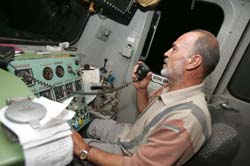Our Services
- Telemetry
- Security Technology
- Payment Architecture Governance
- Parking System Integration
- Research
- Resource Capability


FRMCS (Future Railway Mobile Communication System)
FRMCS Brief Technology Overview
FRMCS is an international, digital mobile communication system specifically developed for railway communication and applications. First developed in Europe, its goal is to achieve interoperability using a single communication platform for both signalling and rail telecommunications. It is used for communication between train and control centres.
FRMCS is a next-generation communication system designed specifically for the railway industry. It aims to replace the existing GSM-R (Global System for Mobile Communications - Railway) with a more advanced and versatile solution. Key technical aspects include:
1.High Reliability: FRMCS ensures robust and reliable communication, crucial for railway operations. It supports features like low-latency communication, minimizing the risk of signal delays.
2. Interoperability: Designed for seamless integration with existing and future railway technologies, FRMCS promotes interoperability among different railway systems and stakeholders.
3. Broadband Connectivity: Unlike GSM-R, FRMCS provides high-speed broadband connectivity. This enables the transmission of large volumes of data, supporting applications such as video surveillance, predictive maintenance, and real-time monitoring.
4. Cybersecurity Measures: Given the increasing threat landscape, FRMCS incorporates advanced cybersecurity measures to protect sensitive railway communication and data from potential breaches.
User Benefits of FRMCS:
1. Enhanced Safety: FRMCS improves safety through real-time communication, ensuring quick response to emergencies and potential hazards on the railway network.
2. Efficient Operations: With high-speed data transmission and improved connectivity, FRMCS facilitates efficient railway operations. This includes better scheduling, monitoring, and maintenance practices.
3. Intermodal Connectivity:FRMCS supports seamless communication between different modes of transportation, promoting intermodal connectivity and enhancing overall transportation networks.
4. Cost Savings: The system's advanced capabilities contribute to cost savings by enabling predictive maintenance, reducing downtime, and optimizing resource utilization.
5. Improved Passenger Experience: Passengers benefit from FRMCS through enhanced communication, entertainment, and information services, making their journey more enjoyable and informed.
6. Future-Proofing: FRMCS is designed to adapt to evolving technologies, ensuring that railway systems remain up-to-date and can easily integrate with emerging innovations in the future.
In summary, FRMCS offers a comprehensive solution for the railway industry, addressing both technical and user-oriented aspects to advance the efficiency, safety, and connectivity of rail transportation systems.
